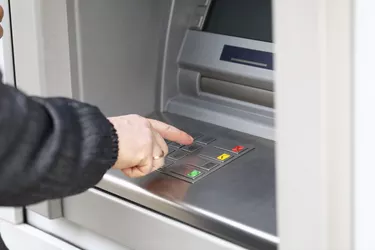
If you received a paper check, you can deposit it at an ATM in fewer clicks than it takes to snap photos and deposit a check through a mobile banking app. When banking in person, depositing at the ATM avoids the hassle of filling out a deposit slip at the bank counter or drive-through.
Depositing a Check by ATM
Video of the Day
If an ATM is the deposit option you choose for your check, you'll need two things: your bank card or debit card and your paper check.
Video of the Day
You must endorse the back of the check before depositing, but it's a good idea to wait until you are at the bank's ATM to do that. If you carry around an endorsed check and lose it, you risk falling victim to fraud if it lands in the wrong hands. Once your check is signed, your ATM check deposit is just a few screen taps away.
- Insert your debit card.
- Select deposit.
- Enter your PIN.
- Select the checking or savings account to receive the funds.
- When prompted, enter the dollar amount of the check deposit and confirm.
- When prompted, feed the endorsed check into the slot.
- Answer any other prompts to complete your transaction.
- Take your card and receipt and ensure the ATM screen has reset and is no longer connected to your banking account.
- Check your receipt to make sure your deposit amount is correct.
Depending on your bank's ATM, the steps may vary slightly. Some ATMs read the check amount and simply ask you to confirm it.
Availability of ATM Deposit Funds
Funds availability may vary from bank to bank. When you deposit cash, the amount is usually available immediately. But with a check, most financial institutions make you wait until the next business day or longer before you can access the money. If the money isn't there, the check deposit will not be approved.
Bank of America's deposit hold FAQs page states that customers can expect to wait for check validation and for the issuing bank to make the funds available. Check with your bank about this and learn the cut-off time for what is considered the end of the current business day. Check your deposit receipt too. Wells Fargo notes that your receipt should indicate when funds will be available.
Most banks do not charge their customers a processing fee at an ATM but consult your account agreement or bank representative to confirm. Federal law states that U.S. banks and other financial institutions must provide written disclosure of all fees associated with their banking services.
Using a Different Bank's ATM
As long as the machine accepts check deposits, you can use any ATM, even if your savings or checking account is at a different bank or credit union. The bank that owns the ATM may charge a processing fee for handling your check, and you'll have to agree to that fee before you can continue with the transaction. However, check with your bank; you may receive credit for those fees on your bank statement.
Check Types You Can Deposit
You should be able to deposit most types of checks through an ATM: payroll, personal, government, cashier's checks and money orders. The ATM may kick a check back if there is something wrong with it, such as an illegible routing or account number or mismatching dollar amounts. You may need to go into the bank if you can't determine what is wrong.
Commonly Asked Check Questions
What Is the Fee for Depositing a Check at an ATM?
The fee for using an ATM is usually between $1 to $5 and may depend on whether you are a customer at the bank that owns the ATM.
For example, with Citibank's Basic Banking Package, there are no fees to use a Citi ATM, but you will be charged $2.50 for using a non-Citi ATM. If your bank's policy is similar, you can use their ATM locator to avoid paying additional fees.
The fees and policies will vary by bank and may change yearly, but they must always be available to you. You can find this through online banking or at your local bank branch.
How Long Does It Take to Clear a Check Through ATM Deposit?
Exact hold times will vary, but you can expect most banks to need at least a business day to verify the check and make the full amount available to you. According to the Office of the Comptroller of the Currency, a bank must make the first $225 accessible as checking account funds or a cash withdrawal within one business day.
However, this can vary based on the type of check you are depositing, the deposit amount and your account history and status. Similar holds tend to apply to mobile check deposits, whereas payroll checks received into your account by direct deposit are often available immediately.
Regarding fees, hold times and policies related to deposits and other financial services, always check with the bank first for specific information.